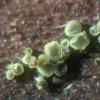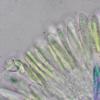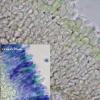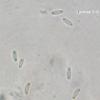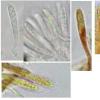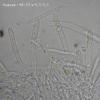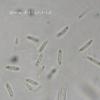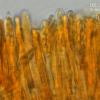
08-12-2025 18:59
 Lothar Krieglsteiner
Lothar Krieglsteiner
.. found by a seminar-participant, I do not know t

08-12-2025 21:04
Mark Stevens"Hello everyone,I'm relatively new to microscopy (

08-12-2025 17:37
 Lothar Krieglsteiner
Lothar Krieglsteiner
20.6.25, on branch of Abies infected and thickened

07-12-2025 16:07
Arnold BüschlenHallo, ich habe in einer Moos-Aufsammlung (epiphy

16-03-2014 22:00
Hello,I found this species a few months ago but ha

08-12-2025 13:39
Thomas Læssøehttps://svampe.databasen.org/observations/10572899

05-12-2025 17:33
 Bruno Coué
Bruno Coué
Bonjour, je serais heureux de recueillir votre avi
Christmas Calycellina
Michel Hairaud,
26-12-2011 12:51
 Bonjour à tous , Hi to everyone,
Bonjour à tous , Hi to everyone,Here are a few pics of an orbilloïd fungus 0,1-0,7 mm large, greenish-yellowish found on inner side of Acer bark yesrterday (December 25)
It would match C. chlorinella but it is on wood (C. chlorinella is supposed to be caulicolous, I already found it on Sambucus ebulus ) and with negative IKI.
Spores would suit C. vulgaris ones' dimensions but I cannot find any description ot pic of this taxon.
Voici quelques images d' disco orbillioïde, verdâtre jaunêtre récoté hier 25 /12 sous l'écorce d'Acer;
Les caractères sont très proches de C; chlorinela que j'ai déjà récolté sur sureau yèbe mais ici les asques sont IKI- et cette espèce est sensée être caulicole.
Merci de vos avis,et documents.
Bonne fin d'année et amitiés à tous
Michel
Hans-Otto Baral,
26-12-2011 13:13

Re : Christmas Calycellina
Hi Michel
the type of Calloria luteola Roumeguère, on stems of Cannabis, is C. chlorinella but with inamyloid asci. See DVD HB 7644.
McPartland & Cubeta, Mycol. Res. 101(7): 854 (1997)?, made a combination in Orbilia (!), therefore, I studied this material.
There is also a find on Salix by Bernd Fellmann, with inamyloid asci (Calycellina chlorinella 15.XI.08).
Was your find some cm or m above ground? Because inamyloidity would suggest that. Do you have a closer photo of a dead ascus apex in IKI, best more immature? I wonder about an apical thickening, because there is an "Orbilia" veratri Velen. (HB 6399) which is similar to this luteola.
Zotto
the type of Calloria luteola Roumeguère, on stems of Cannabis, is C. chlorinella but with inamyloid asci. See DVD HB 7644.
McPartland & Cubeta, Mycol. Res. 101(7): 854 (1997)?, made a combination in Orbilia (!), therefore, I studied this material.
There is also a find on Salix by Bernd Fellmann, with inamyloid asci (Calycellina chlorinella 15.XI.08).
Was your find some cm or m above ground? Because inamyloidity would suggest that. Do you have a closer photo of a dead ascus apex in IKI, best more immature? I wonder about an apical thickening, because there is an "Orbilia" veratri Velen. (HB 6399) which is similar to this luteola.
Zotto
Michel Hairaud,
26-12-2011 16:16

Re : Christmas Calycellina
Thanks, Zotto for your diigent answer.
Yes I had noticed in your DVD the inamyloïd ascus of Roumeguere's collection.
And yes, it was a 20 cm large trunk, ca 1 m above ground .
Here are more ascus pics in water and IKI
Spore guttulation is different from ''O'' veratri in your HB 6399 plate
Michel
Yes I had noticed in your DVD the inamyloïd ascus of Roumeguere's collection.
And yes, it was a 20 cm large trunk, ca 1 m above ground .
Here are more ascus pics in water and IKI
Spore guttulation is different from ''O'' veratri in your HB 6399 plate
Michel
Hans-Otto Baral,
26-12-2011 16:51

Re : Christmas Calycellina
That's fine, a clear apical thickening, but with an middle conical chamber.
It is probable that this is a species different from chlorinella, but perhaps not confined to wood alone.
You said you had a previous collection on Sambucus ebulus. Any pics? Was this also erect and falling dry?
Zotto
It is probable that this is a species different from chlorinella, but perhaps not confined to wood alone.
You said you had a previous collection on Sambucus ebulus. Any pics? Was this also erect and falling dry?
Zotto
Michel Hairaud,
26-12-2011 18:56

Re : Christmas Calycellina
It seems a different fungus indeed, with longer ascus (ca 20 µm longer) , longer spores. and a positive IKI reaction , copper brown at first turning bluish after a while ( don't ask me how long, I did not notice)
I do not remember if the Sambucus stem was still erect
Unless the taxon includes this variability
Here are pics of this collection (MH 181110) made on November 15 last year.
Amitiés
Michel
I do not remember if the Sambucus stem was still erect
Unless the taxon includes this variability
Here are pics of this collection (MH 181110) made on November 15 last year.
Amitiés
Michel
Hans-Otto Baral,
26-12-2011 21:40

Re : Christmas Calycellina
Yes, this sounds for typical chlorinella. The reaction is RB, first blue, at higher conc. red.
Zotto
Zotto
Michel Hairaud,
26-12-2011 23:54

Re : Christmas Calycellina
I noticed the reverse colour transformation but I suppose th ereason is the same (concentration in water)
By the way, is inamyloïdity in more drought resisting apothecia, i.e quite above ground surface, a regular rule ? (As you suggested in your previous answer )?
Michel
By the way, is inamyloïdity in more drought resisting apothecia, i.e quite above ground surface, a regular rule ? (As you suggested in your previous answer )?
Michel
Hans-Otto Baral,
27-12-2011 10:48

Re : Christmas Calycellina
It is a strong tendency but, s any rule, it has its exceptions. F.ex., Mollisia caespiticia and ligni are inamyloid and strictly on xeric substrate. But you can also find some other Mollisias with amyloid rings on such attached branches.
Inamyloid Helotiales that occur strictly on the ground are rare, however, and usually they belong in genera which have all inamyloid asci (e.g., Claussenomyces).
Zotto
Inamyloid Helotiales that occur strictly on the ground are rare, however, and usually they belong in genera which have all inamyloid asci (e.g., Claussenomyces).
Zotto


